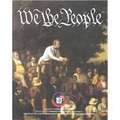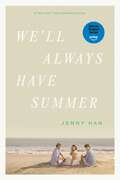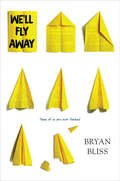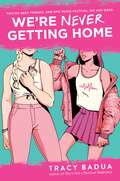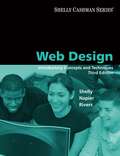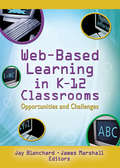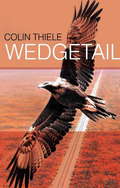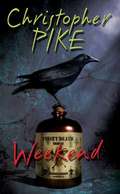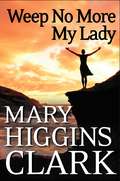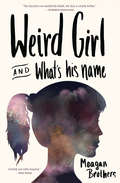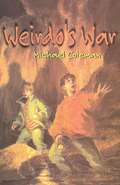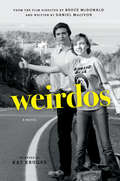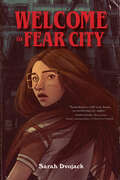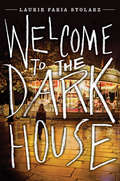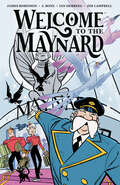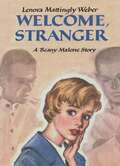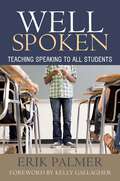- Table View
- List View
We the People… A Middle School Student Text
by Center for Civic EducationThis book is not like most history books. Most history books tell the story of people and events of the past. This book is a history of ideas. It explains the most important ideas of our Constitution and tells how they were developed. It also tells about the people and events that were important in the history of these ideas.
We'll Always Have Summer: The Summer I Turned Pretty; It's Not Summer Without You; We'll Always Have Summer (The Summer I Turned Pretty #3)
by Jenny HanNow an Original Series on Prime Video! Can Belly make a final choice between Jeremiah and Conrad? Find out in the conclusion of the New York Times bestselling The Summer I Turned Pretty trilogy from the author of To All the Boys I&’ve Loved Before (now a major motion picture!).Belly has only ever been in love with two boys, both with the last name Fisher. And after being with Jeremiah for the last two years, she&’s almost positive he is her soul mate. Almost. While Conrad has not gotten over the mistake of letting Belly go, Jeremiah has always known that Belly is the girl for him. So when Belly and Jeremiah decide to make things forever, Conrad realizes that it&’s now or never—tell Belly he loves her, or lose her for good. Belly will have to confront her feelings for Jeremiah and Conrad and face the inevitable: She will have to break one of their hearts. This paperback edition features bonus content, including Conrad&’s letters to Belly and an excerpt of Burn for Burn by Jenny Han and Siobhan Vivian!
We'll Fly Away
by Bryan BlissNational Book Award Longlist Title * Booklist Editors’ Choice * CYBILS Young Adult Fiction Finalist * Nerdy Book Club Award for Best Young Adult Fiction * Paste Magazine Best Book * YALSA Best Fiction for Young Adults“A compelling and raw story.”—Publishers Weekly (starred review)“[Bliss dares] his readers not only to see the depths of human complexity, but to care.”—Booklist (starred review)Luke and Toby have always had each other’s backs. But then one choice—or maybe it is a series of choices—sets them down an irrevocable path.We’ll Fly Awayweaves together Luke and Toby’s senior year of high school with letters Luke writes to Toby later—from death row.Best friends since childhood, Luke and Toby have dreamed of one thing: getting out of their dead-end town. Soon they finally will, riding the tails of Luke’s wrestling scholarship, never looking back. If they don’t drift apart first. If Toby’s abusive dad, or Luke’s unreliable mom, or anything else their complicated lives throw at them doesn’t get in the way.Tense and emotional, this hard-hitting novel explores family abuse, sex, love, and friendship, and how far people will go to protect those they love. For fans of Jason Reynolds, Marieke Nijkamp, and NPR’s Serial podcast.Praise for We’ll Fly Away:"Bryan Bliss has written an empathetic and stirring novel about what it means to fight for the outcasts, the forgotten, and even the hated, reminding us that we all have worth. That we are all valuable."—Sister Helen Prejean, author of Dead Man Walking“A poignant story of loyalty, abuse, and poverty. . . . This compassionate and beautifully rendered novel packs an emotional punch.”—KirkusReviews (starred review)“A smart, rugged, all-too-true story of friendship under fire. Believable characters and page-turning tension.”—Chris Crutcher, author of Staying Fat for Sarah Byrnes“This fast-paced read will have teens tearing through chapters to find out why Luke is in jail. . . . The conclusion will leave them devastated. This is [a] touching book about male friendship for fans of Jason Reynolds.”—School Library Journal“The unshakable and unconditional bond between the young men is tested and proves true, a ray of light in the darkness of their stories.”—VOYA
We're Never Getting Home
by Tracy BaduaHBO’s Insecure meets Dazed and Confused in this messy, tender YA novel about a friendship breakup, set against the backdrop of a chaotic night at a music festival, from rising talent Tracy Badua.Jana Rubio and her best friend, Maddy Parsons, have an epic senior year finale queued up: catching their favorite band at the Orchards, an outdoor music festival a two-hour drive away. When a blowup over Maddy’s time-sucking boyfriend exposes a rift that may have already been growing between them, Jana calls off their joint trip and gets a lift to the festival from her church friend Nathan…only to realize Maddy and her boyfriend are along for the ride, too.All Jana wants is to enjoy the concert and get home as soon as possible. But then Nathan loses his car keys crowd-surfing, and it’s up to Jana and Maddy to find them. As they navigate stolen phones and missing friends, scale Ferris wheels and crash parties, the two of them are forced to reckon with the biggest obstacle of all: repairing their friendship.Will Jana and Maddy find their way home—and also back to each other?
Weather And Climate
by Winston Staff Rinehart HoltExploring, inventing, and investigating are essential to the study of science. However, these activities can also be dangerous. To make sure that your experiments and explorations are safe, you must be aware of a variety of safety guidelines.
Weather and Climate Science
by Glencoe Mcgraw-HillThis series brings together both the underpinning principles and new developments in meteorology for students, as well as being a useful resource for the professional meteorologist or Earth system scientist.
Weather and Climate Systems
by Carolina Biological Supply Company Smithsonian Science Education CenterNIMAC-sourced textbook
Weather and Water
by Lawrence Hall of Science University of California at BerkeleyNIMAC-sourced textbook
Weather and Water
by Lawrence Hall of Science University of California at BerkeleyNIMAC-sourced textbook
Weather and Water Resources: Images, Data and Readings
by Associates FOSS Middle School Project StaffThe book presents the weather and water resources around the world with images and related data and readings.
Web Design: Introductory Concepts and Techniques
by Gary B. Shelly H. Albert Napier Ollie RiversWeb Design: Introductory Concepts and Techniques, Third Edition explains the connection between a detailed design plan that considers audience needs, site purpose, and various technical issues of a successful Web site.
Web-Based Learning in K-12 Classrooms: Opportunities and Challenges
by James Marshall Jay BlanchardMake sure your students get the most from their online learning experiencesEven though nearly every K-12 public school in the United States has broadband Internet access,the Web&’s vast potential as a teaching and learning tool has still not been realized. Web-based learning opportunities have been expensive, slow to develop, and time-consuming to implement, despite pressure on schools to adopt technology solutions that will cure their educational ills. Web-Based Learning in K-12 Classrooms: Opportunities and Challenges chronicles the up and downs of online learning and offers unique insights into its future, providing a comprehensive, curriculum-wide treatment of K-12 content areas (reading, science, mathematics, social studies), special education, counseling, virtual schools, exemplary schools, implementation issues, and educational Web sites.The Internet represents a powerful, complex set of technologies that offers your students access to unlimited knowledge-but that access doesn&’t replace the human interactions found in classrooms. Placing a student in front of a computer monitor is a supplement to classroom learning, not a substitute for it. Academics and education professionals address questions surrounding the key issues involved in successfully incorporating the wide range of Web-based learning opportunities (formal courses, demonstrations, simulations, collaborations, searches) into the classroom, including technology, content, and implementation.Web-Based Learning in K-12 Classrooms examines: inquiry-based learning online interaction displaying student work online Internet accessibility for students with disabilities initiating school counselors into e-learning technologies the role of government in virtual schools Web-based schools in California, Virginia, Pennsylvania, Vermont, and Texas a 13-category classification system for online educational resources the ATLAS model for program implementation evaluations of more than 1,000 pieces of online information (articles, research, reports, news, and statistics) and 900 Web applications (tutorials, drills, games, and tests) with evaluation criteriaWeb-Based Learning in K-12 Classrooms is a vital resource for educators interested in online learning applications across the K-12 curriculum.
Webster's Thesaurus For Students
by Merriam-WebsterThis all-new edition is a must-have resource for students searching for the best word to organize and express their thoughts clearly in speech and writing. Each entry has a brief definition or shared meaning core of synonyms listed. Related words (near-synonyms) and antonyms (words of opposite meaning) help the student understand nuances of meaning. An affordable paperback, this volume is the ideal companion volume to Webster's Dictionary for Students. Features of this Book - More than 85,000 synonyms, related words, and antonyms - Alphabetically organized for quick and easy lookups.
Wedgetail
by Colin ThieleAndy is fascinated by wedgetail eagles. He lies on the shed roofs of his family?s farm and watches them cruising about on their huge wings, high above him in the sunlit air. They are like skaters skimming on ice, gliding in vast arcs and circles. One day a ranger brings him an orphaned eaglet so tiny that it seems unlikely to survive. WEDGETAIL is the story of Andy?s struggle to save it, to nurse it and feed it - and to protect it from danger, human and otherwise.
Weedflower
by Cynthia KadohataTwelve-year-old Sumiko feels her life has been made up of two parts: before Pearl Harbor and after it. The good part and the bad part. Raised on a flower farm in California, Sumiko is used to being the only Japanese girl in her class. Even when the other kids tease her, she always has had her flowers and family to go home to. That all changes after the horrific events of Pearl Harbor. Other Americans start to suspect that all Japanese people are spies for the emperor, even if, like Sumiko, they were born in the United States! As suspicions grow, Sumiko and her family find themselves being shipped to an internment camp in one of the hottest deserts in the United States. The vivid color of her previous life is gone forever, and now dust storms regularly choke the sky and seep into every crack of the military barrack that is her new "home." Sumiko soon discovers that the camp is on an Indian reservation and that the Japanese are as unwanted there as they'd been at home. But then she meets a young Mohave boy who might just become her first real friend...if he can ever stop being angry about the fact that the internment camp is on his tribe's land. With searing insight and clarity, Newbery Medal-winning author Cynthia Kadohata explores an important and painful topic through the eyes of a young girl who yearns to belong. Weedflower is the story of the rewards and challenges of a friendship across the racial divide, as well as the based-on-real-life story of how the meeting of Japanese Americans and Native Americans changed the future of both.
Weekend
by Christopher PikeThe weekend in Mexico sounded like a dream vacation. It should have been perfect, but someone was getting revenge and the terror wouldn't stop till the weekend was over.
Weep No More My Lady: A Novel
by Mary Higgins ClarkNew York Times bestselling author and Queen of Suspense Mary Higgins Clark&’s masterpiece is a &“crackling tale of menace and love that holds your attention to the last page&” (Andrew M. Greeley).Elizabeth Lange has arrived at Cypress Point Spa in Pebble Beach, California, weary of heart and soul. Still grieving for her beloved sister, a famous actress who plunged to her death from her Manhattan penthouse, Elizabeth is determined to unearth the truth about how Leila died. Dashing multimillionaire Ted Winters stands accused of her murder, but Elizabeth has doubts. Along the windswept cliffs of the Monterey coast, in luxurious bungalows, between gourmet meals and beachfront walks, uneasiness stalks Elizabeth while she begins opening doors to the past. As glimpses of the dark truth about Leila&’s life and death—and about Elizabeth herself—start to crash against her mind, an ominous wave from an unexpected source threatens to engulf her entirely.
Weird Girl and What's His Name
by Meagan BrothersIn the tiny podunk town of Hawthorne, North Carolina, seventeen-year-old geeks Lula and Rory share everything-sci-fi and fantasy fandom, Friday night binge-watching of old X-Files episodes, and that feeling that they don't quite fit in. Lula knows she and Rory have no secrets from each other; after all, he came out to her years ago, and she's shared with him her "sacred texts"-the acting books her mother left behind after she walked out of Lula's life. But then Lula discovers that Rory-her Rory, who maybe she's secretly had feelings for-has not only tried out for the Hawthorne football team without telling her, but has also been having an affair with his middle-aged divorcee boss. With their friendship disrupted, Lula begins to question her identity and her own sexual orientation, and she runs away in the middle of the night on a journey to find her mother, who she hopes will have all the answers. Meagan Brother's piercing prose in this fresh LGBT YA novel speaks to anyone who has ever felt unwanted and alone, and who struggles to find their place in an isolating world. Ages 14-up.
Weirdo's War
by Michael ColemanDaniel prefers his own company, as it gives him more time to explore the near magical world of math and physics which so fascinates him. He certainly didn't want to go on a school camping trip with other boys in his class, but his father gives him no choice. "It'll do you good", he said. Daniel can see little good in being stuck in a cabin with three boys who have long tormented him. Especially Tozer, who has terrorized him for years. Things couldn't get any worse than being paired with Tozer for an all orienteering competition, or so Daniel thinks. But when the two of them end up trapped in a cave, along with their mutual enemy, Mr. Axelman, things do get worse. Daniel must find a way to rescue the three of them, before the water rapidly flooding the cave drowns them all.
Weirdos: A Novel
by Kat KrugerIt's the summer of 1976, and Kit is fed up of his small town life in Antigonish, Nova Scotia, where he lives with his Dad and grandmother. Dreaming of a more exciting life in the big city, Kit enlists the help of his girlfriend Alice, and they hitchhike towards a new home with his glamorous, artistic mother Laura. As Kit and Alice reach their final destination, their relationship is tested, and Kit faces a difficult realization that will change his life forever.Kat Kruger's novel adaptation of the film Weirdos retells this tender story of a young man's journey to self-discovery.
Welcome to Fear City
by Sarah DvojackNew York City, summer of '77—in a city on the edge and obsessed with a serial killer, Sylvie Stroud is dealing with an entirely different kind of evil when she awakens a dark magic hellbent on consuming her. Seventeen-year-old Sylvie Stroud can see the past of any building just by touching it. Her powers have always been reliable, until one day she sees the memory of a teenage girl&’s murder without touching anything at all. There's a lot of violence in New York City, especially in 1977, but this is different. When the vision keeps repeating, Sylvie begins to investigate. But doing so accidentally awakens an old, parasitic magic lurking just beneath the surface of her beleaguered city. Now all it wants is Sylvie, and it will go through everyone Sylvie loves to have her. This page-turning horror novel, complete with 22 black and white graphic novel pages throughout, is perfect for fans of Stephanie Perkins and Kendare Blake.
Welcome to the Dark House (Dark House)
by Laurie Faria StolarzWhat's your worst nightmare? For Ivy Jensen, it's the eyes of a killer that haunt her nights. For Parker Bradley, it's bloodthirsty sea serpents that slither in his dreams. And for seven essay contestants, it's their worst nightmares that win them an exclusive, behind-the-scenes look at director Justin Blake's latest, confidential project . Ivy doesn't even like scary movies, but she's ready to face her real-world fears. Parker's sympathetic words and perfect smile help keep her spirits up. . . at least for now. Not everyone is so charming, though. Horror-film fanatic Garth Vader wants to stir up trouble. It's bad enough he has to stay in the middle of nowhere with this group???the girl who locks herself in her room; the know-it-all roommate; "Mister Sensitive"; and the one who's too cheery for her own good. Someone has to make things interesting. Except, things are already a little weird. The hostess is a serial-killer look-alike, the dream-stealing Nightmare Elf is lurking about, and the seventh member of the group is missing. By the time Ivy and Parker realize what's really at stake, it's too late to wake up and run.
Welcome to the Maynard (Welcome to the Maynard)
by James RobinsonFrom the celebrated creators behind Starman and Super Friends comes this magical comics tale of crime and theft in the world of hospitality. Welcome to the Maynard! A grand hotel full of luxury and style…but where the guests are all wizards, witches and mythical creatures!Enter a world of magic, mystery, thrills and fun.Join Philippa (Pip) Dale as she begins her new job as a bellhop (and trainee house detective) at the exclusive Maynard Hotel for Wizards (and folks of a magical ilk). This opulent, amazing hotel exists right under the noses of everyday San Francisco, where real magicians, witches, mystical characters and fantastic creatures all come to stay.However, Pip&’s working days aren&’t merely full of amazing sights and magical experiences, they come with thrills and dangers too. She must try to catch a magical hotel thief, although their strange choice of thefts suggests that murder is the ultimate goal. Can Pip solve the mystery of who the thief&’s target is in time to save the intended victim? And at the same time, she must go about her other duties at the hotel almost all of which involve spells, enchantment, and drama of one kind or another.Helping her are many fun and funny hotel employees, all of them with magic running through their veins too. The Maynard is a unique, special hotel where the strange and mystical come to stay. It truly a place like no other, especially now Pip is on the case to liven things up even more.So check in, sit back and enjoy the fun. Welcome to the Maynard!Collects Welcome to the Maynard #1–#4.
Welcome, Stranger (Beany Malone Series, #10)
by Lenora Mattingly WeberWhen Beany fails to help her friend Miggs avoid a riding accident, she feels guilty and ashamed. Unable to confide in friends and family, Beany finds that she is drawn to Tony Lombard, a handsome young Marine whose charm and gallantry hide a dark secret. The bond between Beany and Tony threatens Beany's friendship with her near-steady, Andy Kern. Meanwhile, Beany's older sister Elizabeth is expecting a baby. Complications arise which test Beany's courage again.
Well Spoken: Teaching Speaking to All Students
by Erik PalmerAll teachers at all grade levels in all subjects have speaking assignments for students, but many teachers believe they don't know how to teach speaking, and many even fear public speaking themselves. In his new book, Well Spoken, veteran teacher and education consultant Erik Palmer shares the art of teaching speaking in any classroom. Teachers will find thoughtful and engaging strategies for integrating speaking skills throughout the curriculum. Palmer stresses the essential elements of all effective oral communication, including:, Building a Speech: Audience, Content, Organization, Visual Aids, and Appearance, Performing a Speech: Poise, Voice, Life, Eye Contact, Gestures, and Speed, Evaluating a Speech: Creating Effective Rubrics,' Guiding Students to Excellence Well Spoken contains a framework for understanding the skills involved in all effective oral communication, offers practical steps and lesson ideas that any teacher needs to successfully teach speaking in a variety of situationsfrom classroom discussions to' formal presentationsand includes a set of tools for studentsfrom how to grab the audience's attention to how to use emphatic hand gestures and adjust speed for effect. Discover why, year after year, students returned to Palmer's classroom to thank him for teaching them how to be well spoken. You may find, after reading this book, that you have become a better speaker, too.
